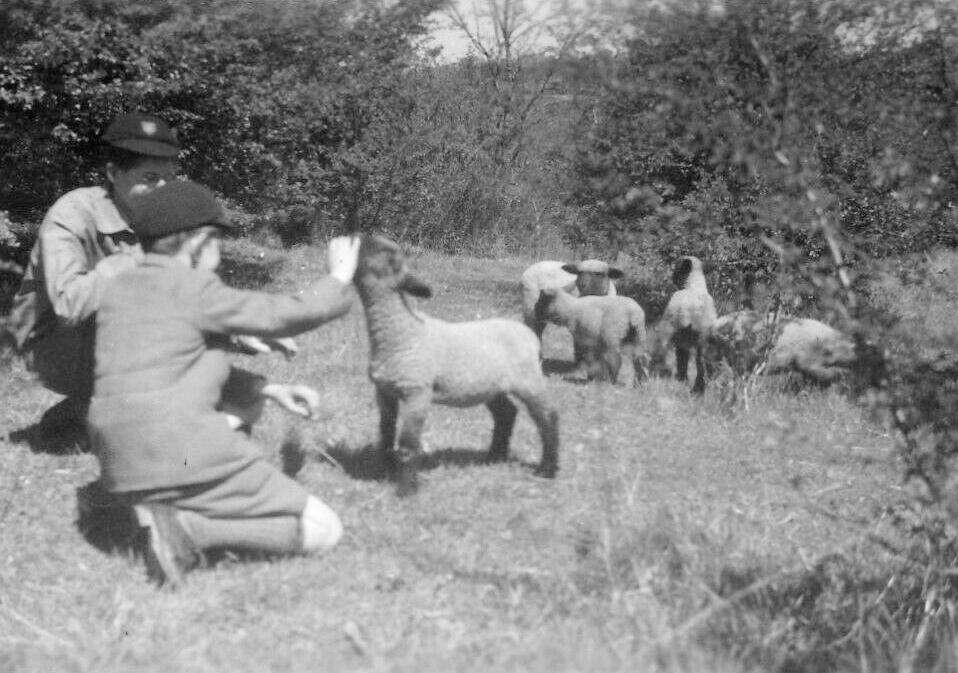
English School Field Trips: Types

Figure 1.--These two unidentified English boys are wearing their school uniform. Notice the caps and shields and the one boy's grey school shirt. We are not sure just where they are, but suspect they are visiting a farm. There is a back note that looks like "Slifton Pits 1951". Slifton is presumably a place, but we are unfamilar with it. 'Pits' could be Pets, but their is a dot over the letter strongly suggesting an 'i'. lick on the image if you want to have alook. All we are sure about is that the snapshot was taken in 1951. A British reader tells us, "Sefton Pits could mean an area near a quarry. It can be a natural or artificial hole in the ground. It can be land excavated to remove mineral deposits. The resulting cavity would be the pit. {British coal mines were called ots.] It can be the shaft of a mine. It can be a concealed hole in the ground made to be a trap. I think the wording refers to a natural exposed rocky ground with a natural occurring large hole. Sefton Pits could be a Liverpool countryside picnic area in a Sefton Park." Doesn't sound to us as the best place to take school kids are to raise lambs, but so be it.
|
|
The chronology of field trips probably depended on the type of outing. There are two basic types of outings. We know that there were outings for celebratory events such as school picnics in the 19th century. These events were a little more complicated in the cities, but of course there were parks. We are less sure when educational outings called field trips were first scheduled. We see some such trips at the turn-of the 20th century in America. We suspect a similar timeline in Britain, perhaps even earlier. We notice several different types of educational field trips. This varied somewhat depending on the age of the children. We think this was most common for primary age children, but we are not quite sure about this. And it may have changed over time. The types we have noted relate to governmental, historical, literary, natural history, occupational, scientific, and sports trips. Governmental trips might mean visits to govrnmental institutions. The historical sites are enumeral in England with all kinds of interesting side stories. Literary trips were a little more limited, but could include the homes of famous authors which ahave been preserved or perhaps a visit to a newspaper. Natural history trips at first meant visits to zoos and museums. Now wildlife parks exist. Visits to esturies and othe ecological zones are now being organized. Occupational trips could include visits to farms and factories. Scientific studies could include museum visits ior the sites like Greenwich. Sports trips could include attending important matches. On the previous page we see a sports trip. We suspect that in recent years there have been ecological trios, but can not yet confirm that.
HBC-SU

Related Chronolgy Pages in the Boys' Historical Web Site
[Main Chronology Page]
[The 1880s]
[The 1930s]
[The 1940s]
[The 1950s]
[The 1960s]
[The 1970s]
[The 1980s]
Related Style Pages in the Boys' Historical Web Site
[Main school uniform page]
[Main country page]
[Long pants suits]
[Short pants suits]
[Socks]
[Eton suits]
[Jacket and trousers]
[Blazer
[School sandals]
Navigate the Boys' Historical Clothing School Uniform Pages
[Main School Uniform Page]
[Australia]
[England]
[France]
[Germany]
[Italy]
[Japan]
[New Zealand]
[Scotland]
[United States]
Navigate the Boys' Historical Clothing Web Page
[Return to the Main English school field trip page]
[Return to the Main English school activities outings page]
[Return to the Main English school activities page]
[Activities]
[Chronology]
[Clothing styles]
[Countries]
[Debate]
[Economics]
[Garment]
[Gender]
[Hair]
[History]
[Home trends]
[Literary characters]
[School types]
[Significance]
[Transport and travel
[Uniform regulations]
[Year level]
[Other topics]
[Images]
[Links]
[Registration]
[Tools]
[Return to the Historic Boys' School Home]
Created: 1:08 AM 6/14/2019
Last updated: 1:08 AM 6/14/2019




